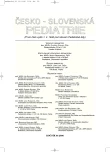Alarm Treatment for Monosymptomatic Nocturnal Enuresis
Authors:
L. Kovács; M. Gecíková; E. Radvanská; S. Rittig 1
Authors‘ workplace:
2. detská klinika Lekárskej fakulty Univerzity Komenského a Detskej fakultnej nemocnice s poliklinikou
Bratislava
; Detská klinika, Skejby nemocnica Univerzity, Arhuse, Dánsko
1
Published in:
Čes-slov Pediat 2006; 61 (3): 123-128.
Category:
Original Papers
Overview
Despite several studies, little is known about the mechanism of action of enuresis alarm systems.
Aim:
The authors studied monosymptomatic nocturnal enuretics (NE) treated with alarm systems for l2–14 weeks with special reference to changes in their functional bladder capacity (FBC).
Patients:
Twenty and one children (13 boys and 8 girls) aged >9 yrs (12.6±0.66 yrs) participated the study. Frequency of daytime voiding, nighttime diuresis as well as the functional capacity of the urinary bladder were evaluated during a 14-days period before treatment and then repeatedly during 6th and 7th and 13th and 14th weeks of alarm therapy.
Results:
Thirteen children achieved success defined as 14 consecutive dry-nights (group S), five were classified as partial success (PS). Data from three children with inability to wake due to alarm were not included. The age and gender were unrelated to outcome, but lower FBC (maximum daytime volume, expressed as percentage of expected volume for age), more frequent daytime voidings and higher relative nighttime diuresis (as % of FBC) were significantly associated with limited effect of the alarm (0.71±0.06 vs. 0.49±0.06, p <0.01, 5.66±0.47 vs. 7.66±0.33, p <0.01 and 1.09±0.08 vs. 1.49±0.14, p <0.01 respectively). In the S group, the ratio of actual to “ideal“ FBC gradually increased from 0.71±0.06 in the initial evaluation to 0.78±0.04 at the 6th–7th week and to 0.83±0.05 after the cessation of treatment respectively (p <0.001). In group PS, this ratio also increased, although in lesser degree from 0.49±0.06 at the initial evaluation to 0.57±0.04 during the 6th–7th week and to 0.63±0.04 following its cessation (p <0,001).
Conclusion:
Low FBC with higher relative nighttime diuresis (given as % of FBC) was found to be an important predictor of alarm failure. This finding reinforces the importance of assessment of the “three systems” before embarking on treatment. A significant increase of FBC may contribute to the efficacy of alarm treatment in patients with higher FBC and without absolute or relative nighttime polyuria.
Key words:
alarm treatment, monosymptomatic nocturnal enuresis
Labels
Neonatology Paediatrics General practitioner for children and adolescentsArticle was published in
Czech-Slovak Pediatrics

2006 Issue 3
Most read in this issue
- X-linked Adrenoleukodystrophy in Twenty One Czech Patients
- Differential Diagnostics of Coagulation Disorders at the Child Age
- Alarm Treatment for Monosymptomatic Nocturnal Enuresis
- Follow-up of Children with Unilateral Multicystic Dysplasia of Kidney
